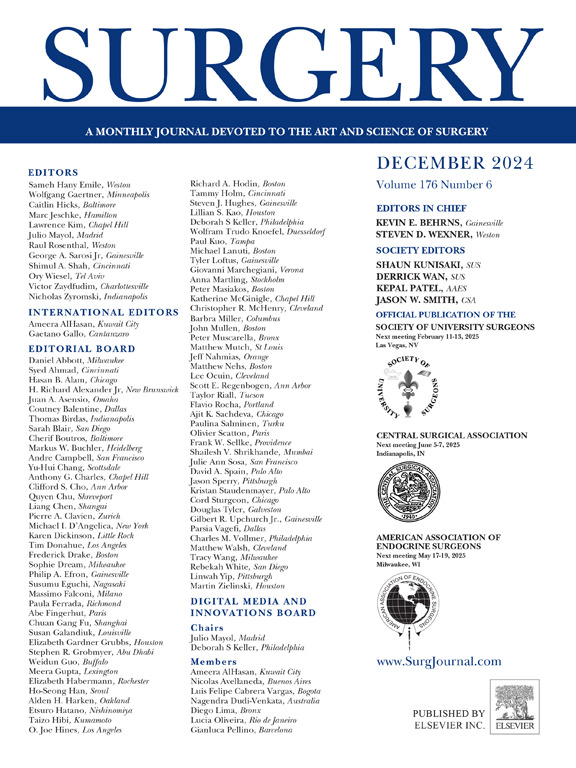It's all in your head: Safety of weight-based, targeted enoxaparin prophylaxis in intracranial hemorrhage patients
IF 3.2
2区 医学
Q1 SURGERY
引用次数: 0
Abstract
Background
Prior studies have demonstrated that 30-mg twice-daily enoxaparin dosing is inferior to weight-based, anti-Xa–targeted dosing for venous thromboembolism prophylaxis in trauma patients. Despite this, many trauma guidelines continue to support universal low-dose enoxaparin (30 mg twice daily) in patients with traumatic brain injury for fear of expansion of intracranial hemorrhage and adverse neurologic outcomes. We hypothesized that weight-based, anti-Xa–targeted dosing is safe in trauma patients with intracranial hemorrhage.
Methods
We retrospectively reviewed patients admitted to a level 1 trauma center with intracranial hemorrhage from 2015 to 2022. Intracranial hemorrhage patients who received weight-based subcutaneous enoxaparin dosing (50–59 kg, 30 mg twice daily; 60–99 kg, 40 mg twice daily; ≥100 kg, 50 mg twice daily) and had a peak anti-Xa level assessed (goal 0.2–0.4 IU/mL) were included. Enoxaparin was cleared to start 48 hours after a stable head computed tomography. Charts were reviewed to assess for intracranial hemorrhage expansion after initiation of enoxaparin.
Results
Of the 509 intracranial hemorrhage patients included, there were 8 patients (1.6%) with intracranial hemorrhage expansion. Of patients given enoxaparin 30 mg twice daily, 1 (1.8%) developed intracranial hemorrhage expansion; the patient also had an initial supra-prophylactic anti-Xa level. Seven patients (1.7%) administered 40 mg twice daily developed intracranial hemorrhage expansion; none of these patients were supra-prophylactic according to their anti-Xa levels. No patients given 50 mg developed intracranial hemorrhage expansion after enoxaparin initiation.
Conclusions
In this single-center retrospective study, initial weight-based enoxaparin dosing in patients with stable intracranial hemorrhages did not result in significant clinical neurologic deterioration, directly challenging current venous thromboembolism prophylaxis guidelines for patients with traumatic brain injury. These results should serve as a platform for multicenter prospective data collection to ultimately determine the safety and efficacy of weight-based enoxaparin prophylaxis regimens in traumatic brain injury patients.

这都是你的想法:以体重为基础,有针对性的依诺肝素预防颅内出血患者的安全性
背景:先前的研究表明,在创伤患者静脉血栓栓塞预防中,每日两次30毫克的依诺肝素剂量不如以体重为基础的抗xa靶向剂量。尽管如此,许多创伤指南仍然支持在外伤性脑损伤患者中普遍使用低剂量依诺肝素(30mg,每日两次),因为担心颅内出血扩大和不良的神经系统预后。我们假设以体重为基础的抗xa靶向给药对于颅内出血的创伤患者是安全的。方法回顾性分析2015 ~ 2022年在某一级创伤中心收治的颅内出血患者。颅内出血患者接受基于体重的皮下依诺肝素给药(50-59 kg, 30 mg,每日两次;60-99公斤,40毫克,每日2次;≥100 kg, 50 mg,每日2次),并评估了抗xa水平峰值(目标为0.2-0.4 IU/mL)。在稳定的头部计算机断层扫描后48小时允许使用依诺肝素。回顾图表以评估开始使用依诺肝素后颅内出血扩大的情况。结果509例颅内出血患者中,有8例(1.6%)颅内出血扩大。在每日两次给予依诺肝素30 mg的患者中,1例(1.8%)发生颅内出血扩张;患者初始抗xa水平也高于预防水平。7例(1.7%)患者给予40 mg,每日2次,发生颅内扩张出血;根据抗xa水平,这些患者均不属于超预防。服用50mg依诺肝素后,无患者出现颅内出血扩张。结论:在这项单中心回顾性研究中,稳定颅内出血患者初始以体重为基础的依诺肝素剂量并未导致明显的临床神经功能恶化,这直接挑战了目前外伤性脑损伤患者静脉血栓栓塞预防指南。这些结果可以作为多中心前瞻性数据收集的平台,最终确定以体重为基础的依诺肝素预防方案在创伤性脑损伤患者中的安全性和有效性。
本文章由计算机程序翻译,如有差异,请以英文原文为准。
求助全文
约1分钟内获得全文
求助全文
来源期刊

Surgery
医学-外科
CiteScore
5.40
自引率
5.30%
发文量
687
审稿时长
64 days
期刊介绍:
For 66 years, Surgery has published practical, authoritative information about procedures, clinical advances, and major trends shaping general surgery. Each issue features original scientific contributions and clinical reports. Peer-reviewed articles cover topics in oncology, trauma, gastrointestinal, vascular, and transplantation surgery. The journal also publishes papers from the meetings of its sponsoring societies, the Society of University Surgeons, the Central Surgical Association, and the American Association of Endocrine Surgeons.
 求助内容:
求助内容: 应助结果提醒方式:
应助结果提醒方式:


